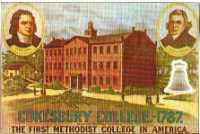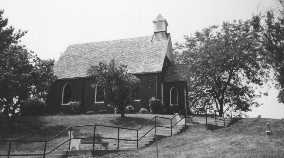The following is a corrected and revised version of the story that appear in the July 8 UMConnection.
BY MELISSA LAUBER
UMCONECTION STAFF
It’s not often that the investigation of a 200-year-old crime finds its way into today’s headlines. But in June, Bonnie McCubbin announced her verdict in the Methodist who-done-it.
 Methodist firebrand, the Rev. James O’Kelly,
torched Cokesbury College in Abingdon in December 1795, McCubbin concluded as part of her
senior thesis at St. Mary’s College, where she graduated from in May.
Methodist firebrand, the Rev. James O’Kelly,
torched Cokesbury College in Abingdon in December 1795, McCubbin concluded as part of her
senior thesis at St. Mary’s College, where she graduated from in May.
Her conclusions, which she announced at Cokesbury UMC, next to the site of the torched institution, were published in a June 3 story in the Baltimore Sun.
The young historian, who has aspirations of becoming a United Methodist pastor, admits that she is not 100 percent certain that O’Kelly is the arsonist and that her case against him is circumstantial, based largely on his dislike of the authority claimed by Methodism’s first bishops and his disagreement that the church should become involved in educational endeavors, rather than sticking to the savings of souls.
While her research was
hailed for its “thorough doggedness” by college officials, some church
historians, like the Rev. Ed Schell, believe McCubbin made an undeserved accusation
against O’Kelly, who he explains was Asbury’s “esteemed longtime president
Elder in Virginia, supervising 28 preachers.”
McCubbin assumes O’Kelly frequented Cokesbury, an impossibility due to his large Virginia responsibilities,” Schell wrote. “Her arson charge largely rests on a misreading of the 1797 Asbury letter to George Roberts, concerning the great 1796 Baltimore fire, which destroyed Light Street Church and the Academy, rather than the 1795 fire at Cokesbury.” said Schell, the former historian of the Baltimore-Washington Conference.
While McCubbin agrees that O'Kelly did have many responsibilities in both Virginia and North Carolina, it is very likely that he had visited the location of Cokesbury College, she said. In an e-mail, McCubbin writes: "According to James Edward Armstrong, Secretary of the Baltimore Conference, Methodist Episcopal Church, South, who wrote the History of the Old Baltimore Conference from the Planting of Methodism in 1773 to the Division of the Conference in 1857, 'Abingdon, the near-by village, attracted attention and grew rapidly. In 1786 the Conference held its session there; and indeed, subsequently, after meeting in Baltimore, would adjourn to Cokesbury College to conclude its deliberations.'
"Additionally, according to P.J. Kernodle's Lives of Christian Ministers (The Central Publishing Company, Richmond, 1909), 'This year, the ‘Council' composed of the Bishop and Presiding Elders, was held at Baltimore (Cokesbury), on the 1st of December, 1789 ... Mr. O'Kelly is said to have taken an active part in the transaction of its business. ...'
"Therefore, since O'Kelly became a preacher by 1778, and several large meetings occurred at the site of Cokesbury College, including at least one example of one he attended, it is reasonable to state that O'Kelly had been to Cokesbury College before the time of the fire in 1795. At the very least, O'Kelly was acquainted with the location," wrote McCubbin.
The two historians do seem to agree that O’Kelly was a thorn in Asbury’s side, railing against the bishop’s appointive power and ended up stomping out of the denomination to begin the Republican Methodist Church.
But, in Schell’s opinion, it was probably a student who set the school afire.
McCubbin refutes this claim, stating in an e-mail that, according to Asbury's Journal and Letters, while Cokesbury was once a boarding school, all the boarders had been dismissed, when on 28 September 1794, at a conference of Methodist clergy, it was ‘resolved that nothing but an English free day-school should be kept at Cokesbury.' As a day school, there would be no boarders (students) around at the time of the fire-midnight.
Of the 825 pastors who joined the Methodist Conference from 1773 to 1799, only one was ever charged with a felony, although some were jailed during the Revolution for preaching without taking the Maryland loyalty oath, Schell said.
While the two don’t completely agree on the history surrounding the fire, their examination has brought the story of the first Methodist school into the public eye.
The idea for Cokesbury College was born at the
Christmas Conference, the founding meeting of the Methodist Church in America, in 1784. 
According to the book “Those Incredible Methodists: A History of the Baltimore Conference of the United Methodist Church,” the school was erected in 1787 for the sons of traveling preachers away from home because of their “labors in the gospel,” boys who were “too big to be under their mother’s direction, poor orphans and the children of our competent friends, who were able to pay for their son’s educations.
The students, who were instructed in English, Latin, Greek, logic, rhetoric and history, rose at five o’clock in the morning, summer and winter, at the ringing of the college bell. The Cokesbury bell continues to be used today at each annual session of the Baltimore-Washington Conference session in the Service of Remembrance.
The rules at the school were strict. Rule 18, for example strictly forbade all play, “for those who play when they are young will play when they are old.”
The school operated for eight years before it experienced the fire of “incendiary origin.” At its height, in 1792, there were 70 students enrolled.
Cokesbury UMC, at 1304 Abingdon Road, which was originally named Abingdon Chapel, was located near the college and escaped any damage from the fire.
